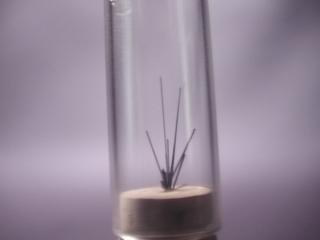 THE MINERAL PSEUDOBROOKITE
THE MINERAL PSEUDOBROOKITE
- Chemical Formula: Fe2TiO5, Iron Titanium Oxide
- Class: Oxides and Hydroxides
- Uses: A very minor ore of titanium and as mineral specimens.
- Specimens
Pseudobrookite is a rare and interesting mineral for collectors.
It forms needle thin, acicular, crystals that form in sprays of several individuals.
Its high luster, due to the titanium content, is rather nice and its rarity makes pseudobrookite an appreciated mineral in most anyone's collection.
Pseudobrookite is associated with many interesting minerals such as
pyroxenes, hornblende, tridymite, topaz, hematite and
bixbyite.
Most of the more popular of these assortments are found in cavities in rhyolitic rock and make for attractive and much sought after mineral specimens.
Nice pseudobrookite specimens come from the Thomas Range in Utah.
PHYSICAL CHARACTERISTICS:
- Color is dark black.
- Luster is metallic to adamantine.
- Transparency: Crystals are opaque.
- Crystal System is monoclinic; 2/m
- Crystal Habits include small acicular or thin prismatic crystals aggregated together in sprays of only a few individuals or singular.
Also tabular.
- Cleavage is indistinct in one direction.
- Fracture is conchoidal.
- Hardness is 6
- Specific Gravity is 4.4 (average for metallic minerals)
- Streak is brownish to reddish yellow.
- Associated Minerals include spessartine, pyroxenes, hornblende, tridymite, hematite, bixbyite and topaz.
- Notable Occurrences are limited to the Thomas Range, Utah and Piski, Transylvania, Romania.
- Best Field Indicators are crystal habit, streak, associations and locality.
 THE MINERAL PSEUDOBROOKITE
THE MINERAL PSEUDOBROOKITE



